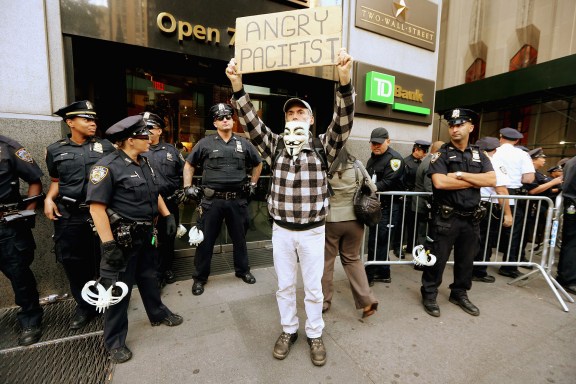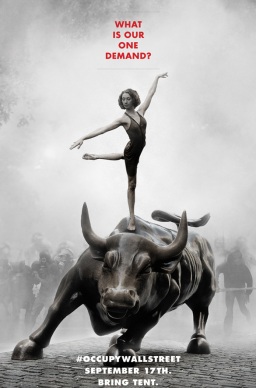Monday marked the one-year anniversary of the movement known as Occupy Wall Street.
According to The New York Times, “the police arrested 185 people on Monday as protesters tried to block access to the New York Stock Exchange on the first anniversary of the Occupy Wall Street protests.”
Protesters gathered and some celebrated by singing “Happy Birthday,” while others demonstrated by walking down sidewalks shouting “We’re still here” and “We’re the 99%.”
The majority of protests were peaceful, and any arrests were a result of disorderly conduct and activists blocking traffic.
###
The seeds of the movement were planted by the Canadian-based activist group Adbusters. Calling for a peaceful demonstration weeks prior to September 17th, the original plan was to stage a protest in a park near Wall Street, New York City’s financial district.
The Washington Post called the event a “day of rage” against “American’s corrupt Democratic process.”
When Occupy Wall Street held its first event on September 17th, comedian Roseanne Barr spoke and around a thousand people showed up. About 80 people stayed overnight in Zuccotti Park, two blocks from Wall Street.
The quote “We are the 99%” emerged in the lexicon of pop culture and referred to the idea that one percent of the United States population controlled most of the wealth and in turn, kept the remaining 99 percent from obtaining a decent livelihood.
While the group’s objectives were intentionally vague, the movement called attention to what they felt was the United States’ social and economic inequality, which could be fixed by restructuring the banking and financial systems.
The occupy movement’s leadership was decentralized, and each camp worked as a mini-democracy.
After about a week of encampment, national media outlets started to take notice. Several hundred people started to camp out and were aided by donations of sleeping bags, tents, food and money.
With the attention, some say the movement lost focus. As massive amounts of people started to pour into the camps looking to voice their own concerns, the message became muddled. Andrew Ross Sorkin, a New York journalist who covered Occupy, said:
“By the second or third time I went down to Zuccotti Park, it became clear to me that Occupy Wall Street, which began with a small band of passionate intellectuals, had been hijacked by misfits and vagabonds looking for food and shelter.”
Hashtags like #occupy started trending on Twitter and every major media outlet reported on the events. Almost every major city in the world had similar protests. Occupy movements sprung up in London, Toronto, Auckland, New Zealand, and San Diego, among others. Each protest acted in solidarity but the New York message about the 99% remained consistent.
While the initial goal was for peaceful protests, Occupy Oakland was marred by a strings of assaults and acts of vandalism. The New York Times reported that a man was shot dead 25 yards from the encampment in November. On January 28th, 2012, Occupy Oakland members vandalized City Hall by destroying children’s art exhibits and setting the United States flag on fire (said to be in retaliation of Oakland Police making several hundred arrests the previous weekend.)
While Occupy Oakland brought a nasty tone to the movement, other Occupy cities worked well with city governments and actually brought a sense of control.
In the late fall, cities around the world started evicting the Occupiers from public places. The NYPD kicked out Occupy Wall Street residents on November 15th, when new rules banning sleeping bags and tents from Zuccotti Park were set in place.
Over the course of the following months, Occupy had morphed and shifted into smaller groups that focused on environmental issues, labor rights, debt, and discrimination. In larger cities, smaller demonstrations took place.
While Occupy cannot claim one new policy or law as it’s own, The LA Times reported that the movement has achieved something. Since the movement has become more decentralized, local factions have become victorious over labor rights and home foreclosures, which embodied Occupy Homes.
Some believe the movement changed the way people think.
“We changed the conversation,” said Amin Husain, a former corporate lawyer who was among Occupy Wall Street’s lead organizers last year. “We’re ringing that alarm bell with our bodies, with our voices, and we’re telling people, ‘Come out in the streets.'”
Only time will tell if this movement will have any lasting change.
— Stew


Think people should hear about this?